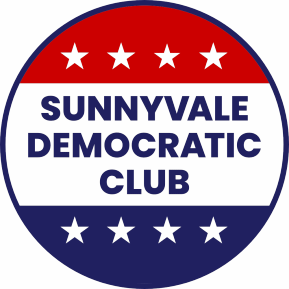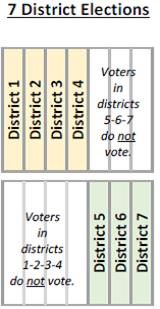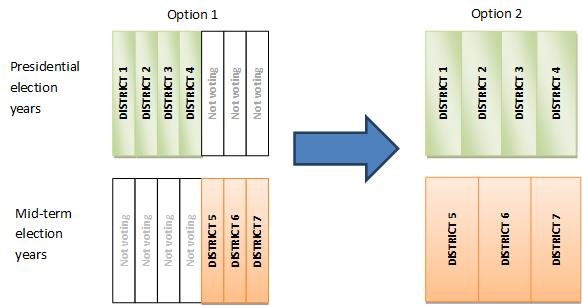| |
| Our Mission and Values |
| Meetup Calendar |
| Board Meetings |
| YouTube Channel |
| Links |
| Join the Club! |
| Contact Us |
Sunnyvale District Elections | ||
Major Changes Are Coming to Sunnyvale ElectionsIn June, the Sunnyvale City Council will be making some major decisions about the way we elect our leaders. While the City has no choice but to change to district elections, there are many different ways to accomplish this. If the Council does not hear otherwise from the voters, they may choose to simply pick one of the alternatives and move ahead. If you would like to see multiple options discussed with the public and at Council meetings, contact the City Council and let them know. The Sunnyvale Democratic Club meeting on May 18th will focus on Sunnyvale District Elections. For more information, go to www.sunnyvaledems.org. Why is Sunnyvale Switching to District Elections?In response to a threat of lawsuit under the California Voting Rights Act, the Sunnyvale City Council has voted to put a measure to amend the City Charter on the March 2020 ballot. If passed, Sunnyvale will switch to electing council members by geographical district starting in November 2020. By putting a Council proposal forward for district elections, the City is trying to avoid legal fees that could be in the millions and would result in a court decision anyway. The bottom line is: Under California law, Sunnyvale must change to district elections. The City has been conducting community outreach on this move to district elections. Please visit their website, SunnyvaleElections.org for more background on the situation and for some participatory tools. District Election AlternativesWhat are our options for district elections? Two primary options are under discussion - one by the City and another introduced by citizen groups, with variants to these two alternatives. Option 1: You don’t get to vote in this election
Is this what we want? Other concerns :
Option 2: Everybody votes(Also known as the 4+3 option) Fortunately there are alternative district schemes available.
There are still seven districts and one council member is still elected from each district in each election. In both cases, there are two maps which alternate every two years. But no one has to sit out an election. An added benefit is that each citizen is represented by two council members, elected in different years, instead of just one. So, if there is a local issue impacting your neighborhood, such as flooding in North Sunnyvale, or the Mary Avenue overpass in West Sunnyvale, or rent stabilization in the mobile home parks, you will have two council members directly accountable to you. Likewise, if there is a concentration of Asian or Hispanic voters in a particular region, districts can be drawn so that these voters can influence elections in both of the alternating election years, potentially electing two council members, instead of being locked out of every other election. Option 3: The number of districts: Why seven districts?Sunnyvale has had 7 council members since at least the 1960s. It is not obvious what the reasons were for choosing that number, but since1960, the population has increased from 53,000 to 154,000. We are now in the process of completely changing our electoral system and the number of seats translates to the number of districts. Is 7 the best number? At the very least, it seems like we should look at 5 or 9 districts and try drawing the maps. Smaller districts will make it easier to create a majority-minority district and further lower the cost of campaigning. On the other hand, the influence of that council seat will be diluted by the increased number of seats. Looking at district maps with a few different configurations will help inform the decision making. The only reason given for not looking at a different number of districts is that it is too complicated. [As a side comment: Since the 1960s this valley has created communications satellites, personal computers, cellphones, genetic engineering, electric vehicles, etc.] Option 4: What about the mayor?Currently, Sunnyvale’s mayor is elected by the council from the sitting council members and all of the council members are elected by the entire city. When we go to district elections, each council member will represent a specific district. Keeping the same system for selecting the mayor means that the representative of Downtown, or South Sunnyvale or Lakewood Village will become the mayor. There will not be a single council member who represents the entire city. Is this what we want? It is true that direct election of the mayor has been on the ballot three times over the years and has been rejected three times, but this is a completely new situation.A mayor elected at-large by all voters would be the only member of the council representing the entire city. Most larger cities that have gone to district election also have a directly elected mayor. If we choose a directly elected mayor, the options above would shift to six districts plus the mayor (or 8 districts or even 4 districts plus mayor). Miscellaneous other optionsThere are numerous other options which could be considered. Ranked choice voting (RCV), single transferable vote (STV) or cumulative voting are examples. These could be implemented city-wide or for each district. District elections are not expected to address gender diversity at all - we currently have only one woman on the city council. RCV or similar schemes would likely increase all types of diversity. If multiple seats are being elected, a candidate can win in a RCV election with much less than 51%. Effectively, this means that voters in a particular ethnic, gender or interest group can create virtual districts to elect candidates, by combining their votes with other voters with common interests. Unfortunately, it is less clear that RCV or similar approaches will survive CVRA court challenges. RCV is also more complicated for the voters to understand. Santa Clara voters rejected a district plan that included RCV, possible because it was too complicated. Can’t the council just pass an ordinance in 20 minutes and move to district elections? We can change it later if it doesn’t work out.Since Sunnyvale is a charter city, any change to the election system probably needs to go to the voters. Even if this was not required, wouldn’t we want the voters to weigh in on a change this significant? After a change is approved we will start electing a new city council based on the new system. The successful candidates will owe their positions to the new voting approach and will be very reluctant to change it. Any changes will likely require a citizen ballot initiative (very difficult) or a change in State law. What is legal under the CVRA?There is no easy answer to this. Because of the threat of millions of dollars in legals fees, the overwhelming majority of cities facing a possible lawsuit have settled before going to court. There have been a variety of solutions. As a result, many possible remedies under the CVRA have not been tested in court. This does not mean they aren't legal. Every action the city takes incurs some risk of a lawsuit. We should try to avoid a costly lawsuit, but we should also ask what is best for the city. Won’t district elections get money out of our city council elections?Thanks to Citizens United, there is no limit to the amount of money that independent organizations or individuals can spend to influence our elections. District elections do make it less expensive for candidates to run, but they also make it cheaper for outside interests to fund a campaign. Since districts are geographically smaller, it does make it possible for candidates and campaigns to physically knock on doors and meet with voters, hopefully, countering the impact of outside money.
| ||
| ||
| ||
LINKS
Comparison of District Elections Options A detailed comparison of different approaches to district elections. |
||
Please take this anonymous online Survey on District Election Options, to add your voice to what will be shared with the City Council. |
||
|


